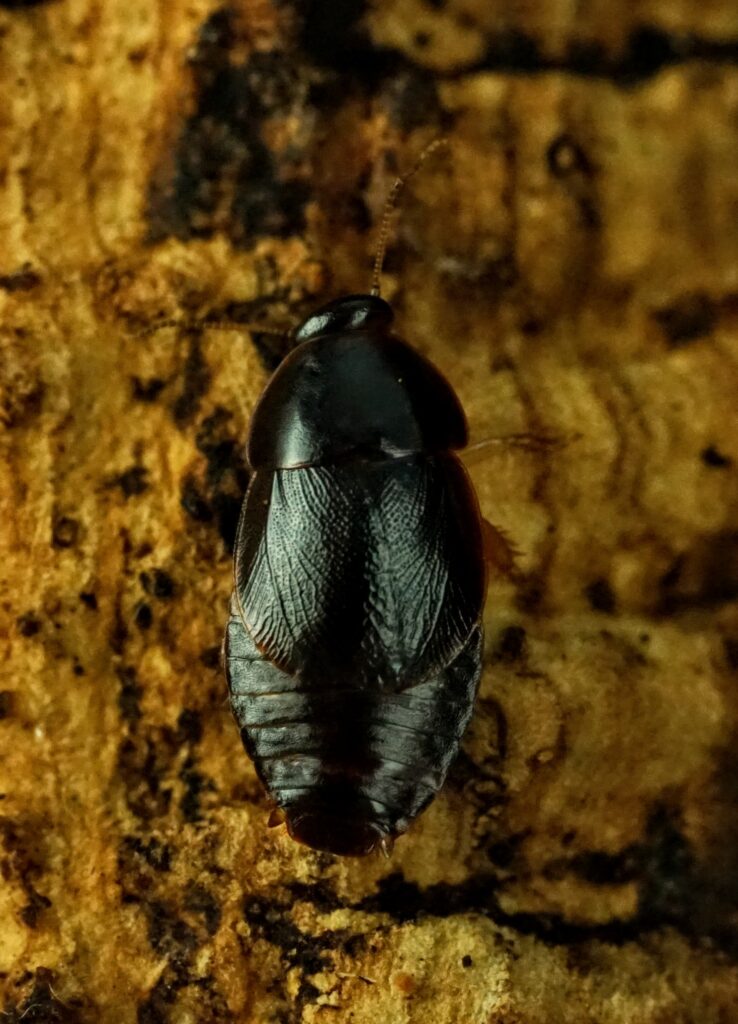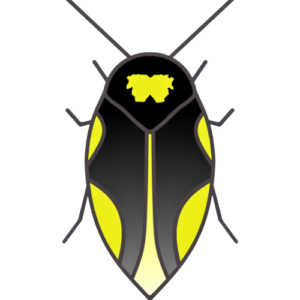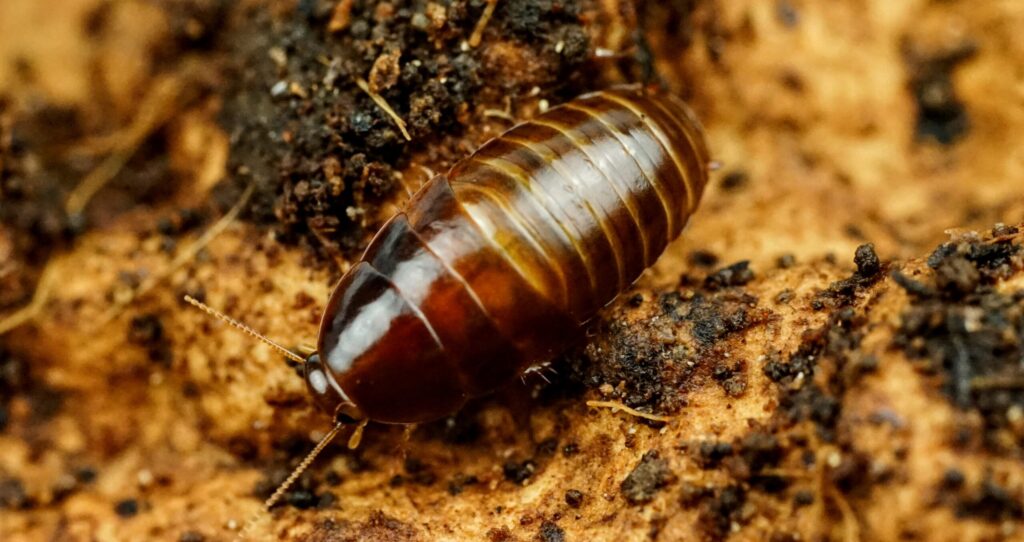
One of the smallest species of cockroaches present in breeding, originating from the African region of the same name. Males reach about 8mm in length and females about 1cm, slightly exceeding this measurement based on the stage of enlargement of the abdomen due to pregnancy. The newly born nymphs will be about 2mm long, relatively large if compared to adult females and the size of the female, and are not able to climb smooth walls (with the sole exception of adult males). Once the last molt is completed, the latter will develop small vestigial wings, absolutely not suitable for flight, and adhesive structures on their legs that allow them to climb plastic, glass and other smooth surfaces. Just like many other species of fossorial cockroaches, they also prefer to bury themselves rather than attempt to escape upwards, an option contemplated only in the case of extremely populous colonies.
Setting up the box
The box must be developed horizontally, as the specimens will tend to remain sunken for most of the time in the first 4/5 cm of substrate, leaving the “aerial” part of the container completely bare. On the lid it will be necessary to cut a large mesh window to ensure good ventilation throughout the box and avoid the proliferation of mold and other harmful fungi.
To prepare the container, insert about 5/6 cm (do not overdo it, I will explain why later) of coconut fiber/sphagnum peat, which will act as a substrate, to which you will need to add, both mixed and superficially, a good quantity of dry oak leaves. They will serve, as explained in the Pycnoscelus sheet, both to maintain constant soil humidity and to feed the specimens themselves. It will therefore be necessary to add them every time we notice a decrease in them.
The addition of bark or wood on the surface of the soil is very useful. These will be used by cockroaches as additional shelter and will greatly simplify the use of this species as a feeding insect (see the paragraphs below for explanation).
Humidity
Paraplecta prefers a constantly humid substrate, be careful not to make it soaked so as not to kill the specimens and favor the proliferation of mold. Equally dangerous is drying out as the nymphs could die both during the moulting process, due to the drying out of the liquid useful for the sliding of the old exoskeleton, and due to long-term dehydration. To understand how much to humidify I recommend reading the “Humidity” section in the Pycnoscelus surinamensis sheet.
Temperature
The species can be kept at room temperature all year round, between 18 and 30 degrees with a gradual change from summer to winter. In this situation, most of the activity will be concentrated in the warm periods, where reproduction, growth of the new born and maturation of the larger specimens will take place.
Being very prolific it can be used as a feeding cockroach, in these cases it could be useful to heat the colony to temperatures of >25 degrees in order to speed up its development and make the continuous collection of specimens less impactful.
Given the fossorial nature of the species, for the administration of the specimens to their respective predators my advice is to exploit the two parameters mentioned a few lines ago: the presence of bark and the inability to climb smooth walls. In fact, most of the individuals will locate themselves underneath the furnishings placed on the substrate, adhering to it with the claws on their paws; this will allow us to lift the furnishings, shake them in a smooth plastic container and have specimens of various sizes available. These can in turn be administered “by drop”, simply by sliding them into the predator’s tank, or with tweezers, selecting them one by one. (with a little practice the process is very quick).
Diet

Their diet does not vary from that of many other species and the rule of mixing dry and wet food applies. As dry food we could provide dog or cat biscuits, pond sticks, fish food, dry bread etc. while as wet food it will be enough to provide fruit and vegetables (notoriously less appreciated), in addition to the dry leaves present in the box. You just have to pay attention to excess food which, given the high humidity required by the species, could cause the proliferation of mites, mold or other pathogens.
Personal considerations
The species is not among the most prolific, not being able to compete with Oxyhaloa deusta, Panchlora nivea, Phoetalia pallida, Pycnoscelus surinamensis or other commonly used ones, but despite this it is included in the personal podium of the best feeding cockroaches.
I give this information following a series of evaluations which I explain below:
- It is one of the smallest cockroaches in breeding, so it can be used for all those predators of tiny dimensions. Personally I have used it with sling fh1 of Cyriocosmus elegans, Kochiana brunnipes, sling i2 of Euscorpius concinnus, Euscorpius borovaglavaensis, Euscorpius garganicus, Chaerilus stockmannorum and variegatus, Phrynus decoratus, Scytodes sp. and others.
- Although it is fossorial, and can therefore escape from predators, it is not aggressive or annoying in the slightest, and does not represent a source of stress for animals in pregnancies, moulting or lacking in appetite (indeed, it will occasionally come out of the substrate in search of food, becoming easy prey for the specimen in question). Therefore, even if more than one falls and is not immediately consumed, it can be safely left in the box without too many worries.
- The newly hatched nymphs are extremely hardy and quickly reach reproductive size, even at temperatures as low as 20 or 21 degrees.
- The inability to climb the smooth, their tendency not to try to escape upwards and their resistance to hyperpopulated environments largely compensate for the low reproduction rate of the individual specimen. Colonies can even number thousands and thousands of specimens without the breeder encountering problems of cannibalism, unsuccessful moults or a decline in reproduction rate, this added to their simple management makes them ideal for many small predators.
Another piece of advice I feel like giving (I’m almost done) is to add some “scavengers” to the box; I’m talking about Trichorhina tomentosa, a small parthenogenetic isopod that feeds on food residues left by cockroaches, dead animals that are not consumed in time and any other organic compounds present in the soil. Especially at the beginning, when the colony still has few specimens, they will prove to be very important for reducing mite infestations and the proliferation of mold.
This is the last paragraph I dedicate to these little cockroaches…
Remember when I said that it is better not to overdo the cm of substrate? Here is the explanation: remember that a substrate is not forever, it must be changed!
Over time, organic debris produced by the thousands of specimens that live there will accumulate in a stratified manner in the coconut fiber. Usually, the lower portions correspond to the most humid, compact and consequently less inhabited ones; these parameters can be used to our advantage for changing the substrate. About once a year, I proceed with the removal of the first cm of coconut fiber, full of paraplecta, and their placement in a temporary box that can contain them until the cleaning is complete. Once almost all the specimens have been removed, I finish eliminating the centimeters of compacted feces remaining on the bottom and cleaning the box. Once everything is cleaned, I reinsert the cockroaches by emptying the contents directly from the temporary box into the permanent one, I add dry leaves and a small part of coconut fiber and that’s it.
In the removed compact substrate, a small number of specimens will inevitably remain; at your discretion, you can try to recover as many as possible by placing bark (the same procedure as explained above for feeding), drop traps, removing them manually, or putting everything in the freezer and using the resulting mixture as fertilizer for plants.
Please remember, NEVER throw the soil with the live specimens outside, you risk introducing an alien species into a new habitat, causing significant ecological damage!
I really hope I have said everything you need to know to best raise the species, if you have any questions or doubts write them below in the comments section, the sheets are constantly updated!
Happy breeding to all!
Card edited by
Lorenzo Pelicella


